Self-loading pistol Hino Komuro (Japan)
A self-loading pistol of the original design was developed in 1903 by a young officer, Kumazo Hino. The twenty-five-year-old soldier proposed his original design of small arms based on unusual ideas and principles of work. Until a certain time, the development of K. Hino could not get out of the design stage, since the inventor simply did not have the opportunity to assemble and test a new weapon. The situation has changed thanks to businessman Tomijiro (sometimes the name Yujiro is mistakenly indicated) Komuro. He paid for all the necessary work and helped to complete the project. In addition, in the future, it was T. Komuro who allowed the pistol to go into series by launching its production at its own factory, Khomuro Jihou Sesacuso.
Thus, the new gun was named after the developer and manufacturer - Hino-Komuro. Some sources also mention that in exchange for assistance with the implementation of the project, K. Hino transferred a patent for a weapon to T. Komuro, however, the existing documents contain both names. This means that the officer and the businessman shared the right of authorship.
A characteristic feature of the K. Hino design pistol was the use of a minimum number of different parts. In addition, all units of this weapon should have smooth contours, giving the pistol an unusual and elegant appearance. At the same time inside the gun should have been located parts that implement an unusual principle of operation based on the roll out of the barrel. Oddly enough, the use of such unusual automation allowed us to significantly simplify the design of the weapon in comparison with other self-loading pistols of the time.
The main part of the gun Hino-Komuro was a large unit that served as a classic frame and casing of the bolt (or a full-fledged receiver). This detail could be cast in the form of a single unit, carry out the necessary processing and equip with additional units installed inside and on external cuts. Thus, it is possible to note not only the unusual appearance, but also the manufacturability of the proposed sample, implemented in the form of the minimum number of parts used.
The upper part of the frame served as the barrel casing and the bolt, and because of its immobility it can be considered the most real receiver. Its front part had the shape of a cylinder, and the middle one received an octagonal section. A rectangular thickening was provided at the rear of this unit. The back wall of the casing-box had a threaded hole for installing the main parts of the weapon and fixing them in the desired position. Inside the "receiver" there was a cylindrical bore to accommodate the trunk. It was proposed to hold the barrel in the desired position by means of an opening in the front wall of the casing, and its breech part should be in contact with the corresponding surface of the internal channel of the casing.
Under the rear part of the barrel casing and the bolt there was a pistol grip with a characteristic influx in the front. In this influx was the trigger. In the stowed position, the hook was almost completely hidden inside its slotted handle, and when cocking the weapon it protruded over the front edge of the handle. The protective bracket was missing. Under the influx of the trigger envisaged a large automatic fuse key. The pistol grip had an oblong shape and was located at an angle to the barrel. In its lower part there was a receiving window for the store. On the side of the metal base of the gun were installed two wooden lining of complex shape with notches on the sides.
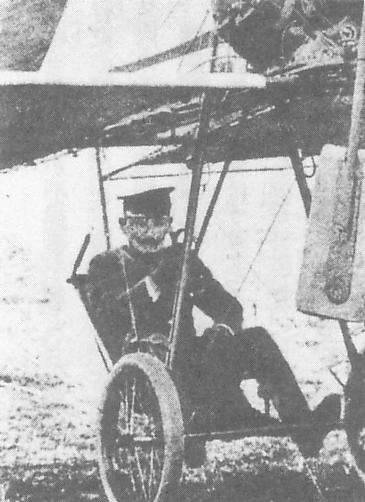
Kumazo Hino as an aircraft designer and one of his airplanes. Photo of Wikimedia Commons
The main internal part of the gun Hino-Komuro was the barrel of a special design. The outer diameter of the barrel was the same in its front and middle parts. The rear, in turn, provided for a thickening for contact with the returnable spring and the inner surface of the casing. In addition, on the underside there was a small groove for contact with the trigger. On the sides of the muzzle of the barrel was provided a notch, which was proposed to be used for cocking the weapon. In the rear section of the chamber, at the top, there was a small cutout for the extractor sleeve.
When assembling weapons, a cylindrical reciprocating combat spring was put on the barrel, after which it was placed inside the receiver. In this case, the muzzle of the barrel passed through the hole in the casing, the thickened breech came in contact with the middle part of the casing, and the spring was sandwiched between the front wall of the casing and the breech barrel. A curious feature of the development of K. Hino was the use of a relatively weak recoil spring. Because of this, in particular, the weapon could be cocked literally with two fingers.
A block was installed into the rear opening of the casing on the threads, which served as a shutter. He was responsible for making the shot and extracting the spent cartridge case. Its base was a cylindrical metal tube with a through hole in the center and a groove at the top. For ease of installation in its place and dismantling the cork had an external rim with a notch. At the front (inner) end of this plug there was a rectangular recess into which a special patrol ram was supposed to enter. It was a rectangular detail with a through hole in the upper part. The rammer could move back and forth, ensuring the correct operation of the ammunition system.
In the central through-hole of the plug-shutter on the thread was fixed drummer. This detail was made in the form of a kind of screw with a large head and stop-washer under it. At the other end of the part (inside the weapon) there was a fixed drummer in the form of a thin needle of the required length. A knot in the form of an L-shaped base with a spring-loaded lever was placed in the upper cork groove. The latter had to grab the sleeve and pull it out of the barrel when fired.
The trigger mechanism had a very simple design, but it was equipped with an automatic fuse. In the influx under the "receiver" was a swinging in the vertical plane trigger, made in the form of a figured plate with holes. Behind the bottom of the hook was supported by a small spring, and the teeth on the top face should have engaged with the groove on the bottom surface of the trunk. The other parts that were responsible for the descent were simply missing. Functions of the trigger and the sear were assigned to one detail of the corresponding form.
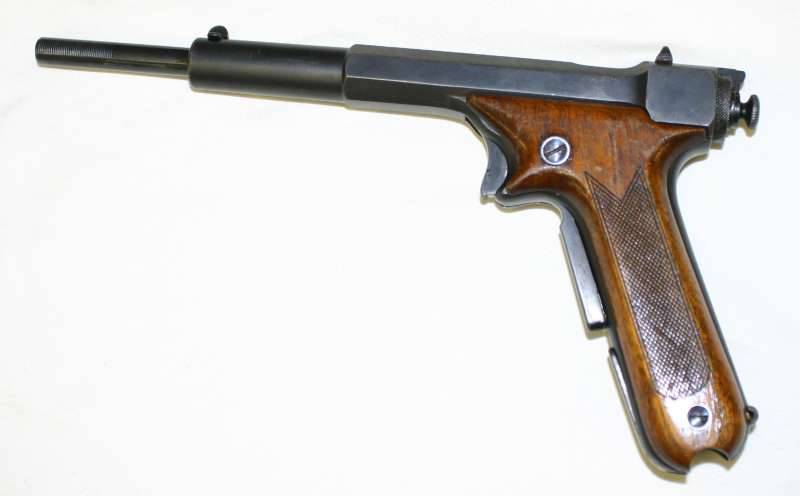
Left view. The weapon is cocked, the barrel is fixed in the forward position. Photo Forgottenweapons.com
Despite its simplicity, the trigger mechanism received a full automatic fuse. On the front edge of the handle, under the fingers of the arrow, there was an oblong key. She was an element of the L-shaped lever, the upper part of which interacted with the bottom of the trigger. When you press a key, the lever swings on its axis and releases the trigger, allowing you to fire a shot. If the weapon was not held with the right grip, then the lever returned to its place and did not allow the hook to move.
It was proposed to carry out the feeding with the aid of detachable box magazines, similar to those used on Parabellum pistols and other weapons of this class, created in the late XIX and early XX centuries. The store should be placed in the reception shaft of the handle. For greater ease of use, an additional handle in the form of a metal cylinder was provided at the bottom of the store, with which it was removed a little faster. Thus, the K. Hino design store almost completely repeated the development of G. Luger. For ejection of the sleeves on the casing, before the rear thickening. Provided oval hole.
The sights of the Hino-Komuro pistol were fairly simple. A semicircular front sight was fixed on the front of the casing-box, and an unregulated rear sight with a central slit was provided above the gate-plug. Such aiming devices allowed firing at a distance of several tens of meters, within the effective range of the used pistol cartridge of relatively low power.
Creating his project, Hino-san decided to use very interesting and unusual principles of automation. It should be noted that similar ideas were implemented both before and after the Japanese project, but the Hino-Komuro pistol was significantly different from all these analogues by its particular characteristics.
To prepare for shooting a gun, Hino-Komuro should have put a magazine in the handle of the weapon and then cocked its mechanisms. An unusual feature of K. Hino’s project was the absence of a manual fuse and trigger guard. Probably, the inventor refused these details due to the fact that the applied design practically excluded an involuntary shot from the traveling position, i.e. without prior cocking. However, an automatic fuse was provided, which allowed a shot only when the handle was firmly held. Such protection systems were considered sufficient.
For cocking the gun should pull the muzzle of the barrel forward, until it clicks. When this occurred, the compression of the recoil-fighting spring, and the lower groove of the barrel caught on the upper tooth of the trigger. In addition, when moving the barrel forward, a rammer, mechanically connected with other parts, moved from its place in front of the gate. He moved forward, pushing the top cartridge from the magazine to the dismounting line, and also not allowing it to fly through the window to eject the liner. A pistol with a displaced barrel and rammer was ready to fire.
The Hino-Komuro pistol was supposed to shoot from the open bolt, adjusted for the original design with a stationary bolt and a moving barrel. When pressing the trigger, the barrel in contact with the compressed return-fighting spring had to move backwards. At the same time, the rammer, who fit in the corresponding cut-out of the shutter, went backwards. At the same time, the needle of the firing pin passed through the hole in the rammer. Moving back, the barrel chamber caught the bullet filed by the cartridge and continued to move. Having reached the extreme rear position, the barrel was finally put on the cartridge, after which the cap of the latter struck the drummer and a shot occurred.
Immediately after the shot, due to the lack of a moving shutter, the barrel began to move under the action of powder gases. The bullet knocked out of the sleeve passed through the rifles of the barrel, crashing into them and transferring some of its energy to the barrel. This energy was enough to move the trunk to the extreme front position, where it was fixed with a trigger tooth. When moving the barrel forward, the spring-loaded extractor held the empty sleeve behind the rim. Then the rammer moved forward again, pushing the cartridge case through the window in the casing. After ejecting the liner and fixing the barrel in the forward position, the pistol was ready for a new shot.
Automatics proposed by the inventor Kumazo Hino had several advantages over other schemes. First of all, it should be noted that the movable barrel, which begins its movement before the shot, allowed to reduce the recoil of the weapon to a certain extent. Moving back a fraction of a second before the shot, the barrel should have created an impulse that pushed the weapon forward and with its help partially quenched the impulse from the powder gases and the bullet directed in the opposite direction. Thus, the pulses were partially compensated and reduced the overall impact on the gun.
The second advantage was the comparative simplicity of the design in terms of adaptation to new ammunition. The applied automatics based on a roll-out of the barrel did not impose special requirements on the cartridge, which allowed K. Hino to develop and put in a series several modifications of his pistol for various ammunition. According to various sources, at least three such modifications were made.
You can also note the relatively high safety of weapons with proper use - but only with the right. A spontaneous shot without preliminary cocking and moving the barrel to the front position was impossible, and an automatic safety device had to prevent the accidental shot of the cocked weapon with the barrel fixed in the front position. Thus, the pistol mechanism could be considered relatively safe, although from the point of view of a European or American school of guns, weapons should at least be equipped with a trigger guard.
At the same time there was a characteristic problem. If during cocking the weapon does not bring the barrel to the extreme front position and does not fix it there, the reverse movement of the barrel under the action of the spring could lead to a shot with unpredictable consequences. Similar problems were not taken into account by the design of the pistol and, in fact, were left at the mercy of the accuracy of the arrow.
Another serious problem of the project, which impeded the use of weapons, was in cocking mechanisms by shifting the barrel. When preparing for shooting, this procedure was simple, but after shooting one or two stores, the barrel heated up and did not allow the shooter to work with his bare hands. Any regular means of solving this problem were absent. Probably, it was proposed to monitor the consumption of cartridges and, after using the latter, change the magazine without pulling the trigger. In this case, the automation was used like a slide lag, allowing you to continue firing without manually reloading the weapon.
According to reports, the project of a prospective self-loading pistol was developed by K. Hino in 1903 year. After this work for a while stopped. The participation was assisted by T. Khomuro, who agreed to pay for the continuation of the work and organized the mass production of weapons at his own enterprise, Homuro Jiuhou Seisacuso. Prototypes successfully coped with the tests, after which mass production of the new pistol was launched at one of the Japanese enterprises. The first Hino-Komuro serial products were shipped to customers in 1908 year. In the same year, the inventor and the merchant received several patents, both in Japan and abroad.
As already mentioned, the automation of the development of K. Hino made it possible to use cartridges of various types. The result was the appearance of several modifications of weapons with different barrels, ammunition supply systems, etc. There is information about the production of Hino-Komuro pistols in versions for .32 ACP (7,65x17 mm Browning), .25 ACP (6,35x15 mm Browning) and 8x22 mm Nambu chucks. Due to the lack of information about the project it cannot be ruled out that other versions of the pistol that could use other types of cartridges were supplied to customers. Pistols could be equipped with box magazines with a capacity from 7 to 15 cartridges, depending on the type of ammunition used.
The Hino-Komuro pistol series production began in 1908. A new product that entered the arms market attracted the attention of potential buyers, but this interest was fleeting. Most of the shooters preferred to acquire the well-known designs of recognized leaders in the arms market, and a new domestic pistol could not count on recognition and large orders. In addition, a noticeable problem pistol could create the risk of spontaneous shot when improperly loaded and inconvenience recharge due to the heating of the barrel. Despite the lack of enthusiasm among potential buyers, Tomijiro Homuro retained the production of weapons for several years. The last batch of pistols was made in 1912 year, after which their production ceased due to the lack of commercial prospects.
For four years, the factory T. Khomuro produced a relatively small number of pistols designed by K. Hiro. According to various sources, their number did not exceed 1200 units. In this case, there are less optimistic estimates - no more than 500-600 pieces. All these weapons were bought by private buyers, which could affect its future fate. It is possible that some samples of the Hiro-Komuro pistol survived until the Second World War and were used by their masters in battle. Due to certain circumstances, the overwhelming majority of Hiro-Komuro pistols did not survive to our time, and the remaining samples represent a special collection value.
In December, 1992, a real sensation occurred. At one of the Japanese warehouses, 17 Hino-Komuro pistols were randomly found in the version for the .32 ACP cartridge. This weapon has lain for several decades in a mothballed form, being forgotten by its former owners. After the discovery of seven pistols were sent to the study of criminologists, and the rest, according to available data, it was decided to destroy. This weapon did not have official registration, which is why the police took such a step. Whether these plans were fulfilled is unknown.
According to various data and estimates, no more than a dozen Hino-Komuro pistols for different cartridges have been preserved. Due to its rarity, these weapons are of particular interest to collectors and are evaluated accordingly. For example, in November 2009, one of the pistols chambered for 8х22 mm Nambu left the auction for almost 19 thousand US dollars. Other samples of these weapons may have no less value.
Hino-Komuro self-loading pistol appeared at the beginning of the last century and was based on unusual technical solutions. Probably, it was the unusual design in combination with some shortcomings that did not allow the gun to win a place in the market and go into a large series. Nevertheless, it was the non-standard type of automation and the small number of released pistols that allowed K. Hino's development to gain well-deserved popularity several decades after its appearance. Thus, the weapon still waited for its finest hour. As for its creator, the self-loading pistol was apparently the first and last development of Kumazo Hino in the field of small arms. Later he took up the topic of aircraft and became one of the founding fathers of the Japanese aviation.
On the materials of the sites:
http://forgottenweapons.com/
http://gunsite.narod.ru/
http://historypistols.ru/
http://zbroya.info/
http://strangernn.livejournal.com/
US Patent for Hino-Komuro Pistol:
https://google.com/patents/US886211
Detailed photo review of the gun:
http://forgottenweapons.com/early-automatic-pistols/hino-komuro-1908/
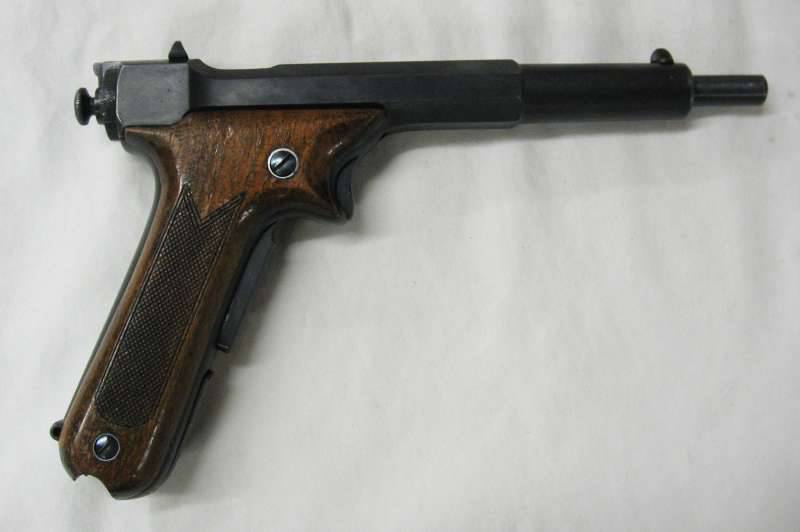
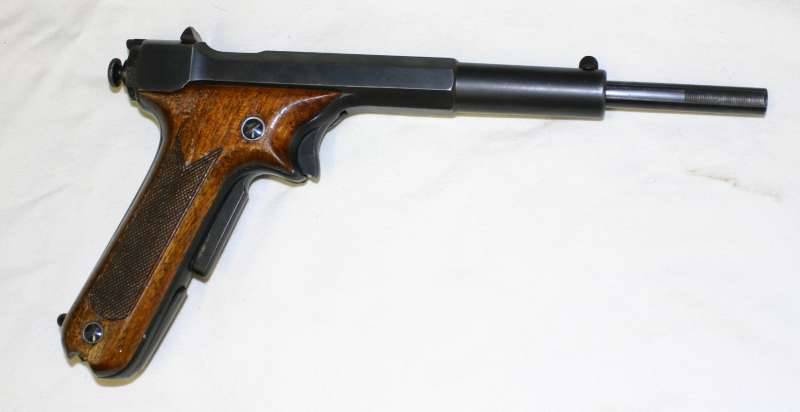
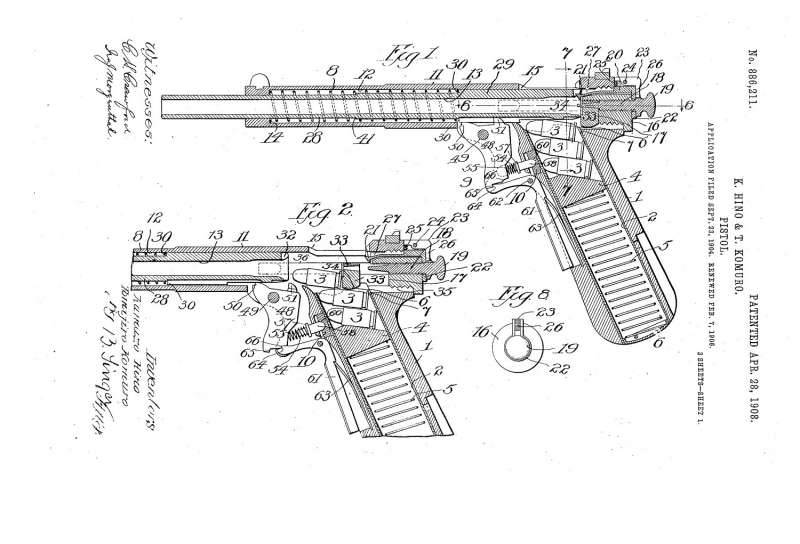
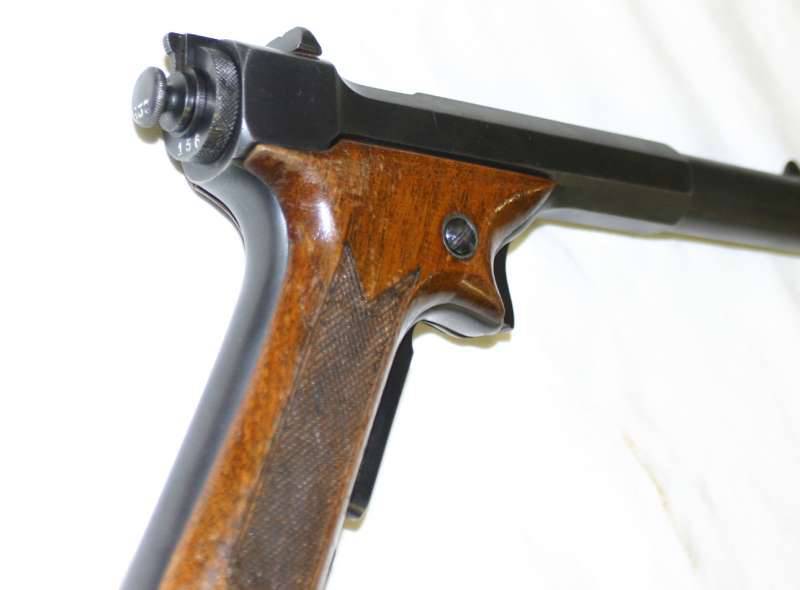

Information